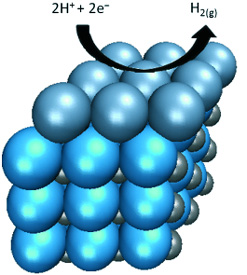
This material can be used to make a electrocatalyst with the same hydrogen evolution reaction (HER) activity as bulk platinum, producing hydrogen effectively and cheaply.
Platinum is the material of choice because of its high activity – unfortunately it is very expensive, currently costing around 52 dollars a gram. "Its high price and limited availability are the biggest stumbling blocks on the way to the mass production of hydrogen through electrolysis," said Jingguang G. Chen, who led the research.
Existing attempts to deposit platinum particles onto a support, have not been efficient enough, according to the researchers, because the platinum atoms can settle too far inside the porous support and are shielded from the reaction. "Our aim was to deposit a single layer of platinum atoms onto an inexpensive planar support so that all the platinum atoms can participate in the reaction,” Chen added.
However, when a monolayer of metal atoms is deposited onto a support, the atoms can interact with the substrate and the electronic structure of the atoms can change because the distances between the individual atoms in the layer can be different from those in the pure metal.
When the University of Delaware team deposited thin films of tungsten carbide onto a tungsten substrate and added platinum atoms by vapour deposition they found that the chemical and electronic properties of these atomic platinum monolayers on tungsten carbide did not differ significantly from those of a block of pure platinum.
"Tungsten carbide is the ideal substrate for platinum," reported Chen. "It is possible to use significantly smaller amounts of platinum, which reduces the cost – possibly not just for water electrolysis, but also in other platinum-catalyzed processes."
The research was reported in the journal Angewandte Chemie.


